摘要
橄榄岩包体是由碱性玄武岩或金伯利岩由上地幔携带至地表的物质,是人们了解上地幔的"窗口",为研究上地幔的成分、结构构造、温压条件、深部地质过程提供资料,对地球动力学研究具有重要意义.长白山橄榄岩包体位于华北克拉通东北缘,包体特征的研究能够揭示陆下岩石圈地幔的性质,并为区域构造演 化提供制约.前人对于该地区大陆下部上地幔岩石圈流变学性质的了解仅局限于地球物理、地球化学等间接推断,缺少从橄榄岩包体的角度直接获取.本次研究我们选取一批新鲜的长白山橄榄岩包体,通过包体的矿物成分和化学成分、P-T条件、显微结构,以及包体中橄榄石和辉石的晶格优选方位(LPO)系统研究该地区陆下岩石圈地幔流变学特征,限制大地构造环境.成分分析表明,这些包体中,橄榄石以镁橄榄石为主,Mg#值为 89-91,代表包体所在区域的上地幔为过渡型地幔.显微构造分析表明橄榄石是以高温位错蠕变为主,显微构造样式主要包括位错壁、扭折带和亚颗粒等.电子背散射衍射分析表明该地区的橄榄石的织构是典型的 A 型组构((010)[100]为主要活动滑移系,形成于含水量低,应力低,温度相对高的环境),A 型组构也是典型的天然橄榄石的组构.对包体中平衡矿物对的计算获取橄榄岩包体的平衡温度介于 850℃-1100℃之间.对橄榄石可观察的重结晶颗粒粒度大小进行统计,利用橄榄石应力计计算出的的包体差异流动应力范围 22-36 MPa,在中国东北地区正常的应力值范围内,属于正常地幔稳态流变应力.在获取上述参数的基础上,本文通过高温流变律的计算获得的上地幔应变速率 约 为 1.5×10-15-1.1×10-11s-1 , 等 效 粘 滞 度 约 为8.5×1011-6.6×1015MPa·s.本文通过对长白山橄榄岩包体的具体研究,首次获取了该地区上地幔具体的流变学条件和组构特征,为该地区大地构造活动提供了流变学约束,也为该地区的后续研究提供了新的参数.
关键词:橄榄岩包体,流变学特征,晶格优选方位,吉林长白山
ABSTRACT
Mantle peridotite xenoliths are carried out by alkaline basalt or kimberlite from theupper mantle to the surface. It provides a unique "windows" for people to understandand study the upper mantle composition, structure, thermal state, lattice preferredorientation(LPO) of olivine and pyroxene and deep geological processes of the uppermantle. And thus, it is of great significance for the geodynamics. Mantle peridotitexenoliths in Changbai Mountain area, located near the northeast part of the edge ofNorth China Craton constrain the nature and evolution of the underneathsubcontinental lithospheric mantle(SCLM). In fact, research on these peridotitexenoliths in Changbai Mountain are few and some extent will filled up the gaps in theprevious studies that relying on geophysics or geochemistry. Here, we report majorelement composition of the xenoliths minerals, the P-T conditions, xenolithsmicrostructure, and olivines and pyroxenes fabric in Changbai Mountain area. And,the subcontinental lithospheric mantle in this area is constrained. Olivine in xenolithsis mainly belong to forsterite with Mg# value between 89-91. Microstructures arecharacterized by free dislocation, dislocation walls, kink bands, subgrains and so on,indicating a high temperature plastic deformation. The fabric of olivine is a typicalA-type (010)[100] is considering as the dominant activation slip system, with lowwater contents and low stresses and maybe with a wide range of temperature). Theequilibration temperature conditions, calculated based on equilibration mineral parts,indicate the evolution of peridotites in a the range of 850-1100 ℃. The differentialstress computed by the size of recrystallized grain is 22-36 MPa. Based on thosecondition parameters and flow law estimated by laboratory deformation data, wecalculated the effective strain rate of the upper mantle is about 1.5 × 10-15-1.1 ×10-11s-1, and the effective viscosity 8.5 × 1011-6.6 × 1015MPa ? s. The study is thefirst time directly reveal rheological and fabric properties of the upper mantle inChangbai Mountain, of which will provide constraints for the geodynamic activitiesand give new data for further research.
Key word: mantle peridotite xenoliths; rheological properties; lattice preferredorientation; Changbai Mountain, Jilin
目录
第一章 绪论.......................................................................................................1
1.1 引言...........................................................................................................1
1.2 研究现状及存在的问题...........................................................................3
1.3 研究思路及主要研究内容.......................................................................4
1.4 论文工作量...............................................................................................5
第二章 区域背景与构造地质...........................................................................6
第三章 岩石矿物学特征...................................................................................8
3.1 手标本宏观特征.......................................................................................8
3.2 薄片显微特征...........................................................................................8
第四章 矿物化学成分特征.............................................................................10
第五章 流变学特征.........................................................................................14
5.1 温度-压力条件.....................................................................................14
5.2 差异流动应力.........................................................................................15
5.3 应变速率与等效粘滞度.........................................................................15
第六章 岩石组构学特征.................................................................................17
6.1 EBSD 技术与橄榄石组构简介 ...........................................................17
6.2 包体组构特征.........................................................................................19
第七章 讨论.....................................................................................................22
7.1 流变学特征的讨论.................................................................................22
7.2 华北克拉通边缘上地幔性质的异同.....................................................22
第八章 结论.....................................................................................................25
致谢 ......................................................................................................................26
参考文献 ..............................................................................................................27
附录 ......................................................................................................................35
第一章 绪论
1.1 引言
地球深部上地幔的研究通常是利用地震波反射等地球物理手段获取结构,通过元素成分迁移等地球化学手段来获取成分、演化等信息.这些信息都是间接推导获取的,存在一定的非真实性.而橄榄岩包体被认为是由碱性玄武岩或金伯利岩自上地幔携带至地表的地幔物质,是人们了解上地幔的最佳"窗口",为研究包体所在区上地幔的成分、结构构造、热状态、深部地质过程提供资料,这些是对区域构造和模型的重要基础制约,因而对地球动力学研究也具有重要意义.
国内外对于包体的研究,早在上世纪 20 年代,Wagner(1930)提出金伯利岩中的一套橄榄岩-榴辉岩是从上地幔被带出的物质,这种认识在后续的研究中获得很多的支持.此后,50 年代初期 Ross 等(1954)介绍了碱性玄武岩中的富橄榄石的包体,并对包体进行岩石学研究,结合矿物学和地质学的关系,得出富橄榄石的包体是被玄武岩浆从深部携带至地表的.60 年代开始对于包体的研究具有系统性的特征,但是仍然以岩石学研究为主.到了七十年代随着科技手段和对包体重要性的认识,学者们开始对包体的岩石学、矿物学、微量元素地球化学、同位素地球化学及动力地球化学等各个方面进行详细的研究.此外,对实验岩石学特别是高温高压实验的探索积累了大量资料,为地球深部岩石,矿物稳定区和岩浆生成的物理化学条件等方面提供可对比参考的数据.近年来,对于包体的研究除了对基础地质的认识,开始更聚焦在大的构造问题和事件,以涉及到对原始地幔的组成、结构、演化和地幔交代,以及地幔柱对岩石圈的影响等方面的研究为主.
我国对于包体的研究起步较晚,在 70 年代之前,有个别的学者报道过个别区域的玄武岩中的包体,例如,曲元贵等(1959)通过对长白山区玄武岩观察,发现其中的橄榄岩球,并初步判断橄榄岩是被玄武岩携带至地表的.在 70 年代中期,我国开始侧重于对包体,主要是对岩石学和岩石化学方面的研究和积累,例如周新华等(1979)通过对南非金伯利岩中橄榄岩包体的结构和化学成分的研究,得到包体在两个不同深度内生成的信息.80 年代后,包体的研究工作才逐渐系统地、全面地展开,以曹毅等人对秦岭造山带中松树沟橄榄岩包体的分析为例:2016 年对松树沟橄榄岩包体的成分进行分析,得到该地区岩石圈地幔为难熔型古老地幔,并曾发生复杂的高温玻安岩熔体熔融和与岩石反应的过程(Cao etal., 2016),并在 2017 年通过对松树沟区域内的纯橄岩和方辉橄榄岩包体中橄榄石组构的分析,发现包体中存在高温类型组构(粗粒纯橄岩中强的 A 型和 D 型组构,弱的 C 型组构和尖晶石相纯橄岩中的 B 型组构以及粗粒方辉橄榄岩中的任意组构)和低温类型组构(碎斑状纯橄岩中弱的 AG 型组构和细粒纯橄岩中弱的 B 型组构),结合之前的构造位置研究,得出该地区碰撞造山带的环境是弧前地幔至大陆下地壳为低温环境,并在该环境中发生地幔的部分熔融和熔体与岩石圈反应的过程(Cao et al., 2017),在 2018 年利用对松树沟包体中橄榄石的地震各项异性进行分析,结合该地区上地幔环境(水含量和 P-T 环境)和橄榄石的晶格优选方位,得出地震波各向异性与温压环境成正相关,且碎斑状纯橄岩的地震波各向异性和强度可通过 70%-90%的动态重结晶颗粒建模(Cao et al., 2018).
在中国东部大量的新生代玄武岩广泛分布,而在碱性、偏碱性的玄武岩中,存在丰富的地幔包体(特别是橄榄岩包体).这些包体被玄武岩直接带离地幔,出露地表,包含了中国东部大陆岩石圈组成、流变学性质和构造演化的重要信息.为揭示这些特征和信息,国内许多学者对东部的橄榄岩包体从不同角度进行广泛的研究(徐义刚等,1996;陈孝德等. 1997;方同辉等,1999;金振民等,2003;周琴等,2007;干微等,2011;徐荣等,2013;李曙光等,2018),为深入研究中国东部大陆岩石圈地幔的形成和演化提供了重要依据.在中国东部重要的构造单元上,位于华北克拉通东北缘的中国东北地区广泛分布新生代玄武岩,玄武岩中含丰富的地幔橄榄岩包体.国内近期以地化所徐义刚院士、中科院吴福元院士、武汉地大郑建平教授等为代表的研究者从地化角度进行了深入研究,为华北克拉通的破坏主题提供了新的认识和制约(郑建平等,2007;吴福元等,2008;郑建平等,2018).而中国长白山地区,橄榄岩包体的研究尚未见报道,处于空白区.
对于长白山橄榄岩包体的研究,不仅可以帮助我们了解包体所处地区的上地幔物质成分的地球化学特征和上地幔温压环境等信息,还可以帮助我们获悉包体所处的地区新生代岩石圈地幔的形成和演化等深部作用过程.长白山火山作为西太平洋俯冲过程中重要的记录和组成者,包体所含的深部信息最终能够为东亚地区大的构造模型,例如"大地幔楔"等提供进一步的数据和制约.
1.2 研究现状及存在的问题
长白山地区靠近中朝边境,属于华北克拉通东北缘.地域上而言.前人对华北克拉通东北缘的幔源包体的研究十分丰富,研究位置主要集中在辽宁宽甸(刘从强等,1993; 方同辉等,1999;徐荣等,2013),吉林辉南(罗照华,1984;干 微等,2011),吉林汪清(赵起超等,2015)和吉林龙岗地区(干微等,2011;赵起超等,2015)(图 2)其中,属龙岗火山群的地幔包体研究程度最高.龙岗火山群主体位于吉林市辉南县境内,该地区的包体常出现在碱性玄武岩和火山碎屑岩中,幔源包体主要为尖晶石相,岩性为二辉橄榄岩和方辉橄榄岩,也有报道少量纯橄岩的存在.龙岗火山群橄榄岩包体的矿物成分研究结果表明,龙岗地区岩石圈上地幔主体类型为饱满型地幔,上地幔的部分熔融程度低于 10%,Re-Os 同位素研究表明也存在难熔型地幔(Wu et al., 2003;支霞臣等 2004;张志海等,2006),包体矿物微量元素之间的相关性进一步揭示了该地区地幔可能经历了以硅酸盐熔体为主的复杂的交代作用(鲁江姑等,2011).此外,关于龙岗地区方辉橄榄岩包体的成因还存在一定分歧.徐义刚等观察到方辉橄榄岩中明显的二次重结晶结构并且地球化学特征与法国中央高原 Boree 包体类似,因而认为其是地幔-熔体之间相互反应的产物,可能代表软流圈上涌侵入岩石圈地幔之后的产物(徐义刚等,2003).另一种观点则认为该区的方辉橄榄岩是二辉橄榄岩低程度部分熔融的产物(杨清福等,2011, Jian,2012).无论何种观点,基于方辉橄榄岩包体中的LREE 和 LILE 变化趋势以及包体全岩化学特征和矿物化学成分特征,大部分学者都认为辉南地区的上地幔自中生代以来被与大洋地幔相似的软流圈地幔所代替(徐义刚等,2003; 杨清福等,2011; Jian,2012; 赵起超等,2015).
此外,其他相邻区域的橄榄岩包体对该地区上地幔的流变学特征的研究也有报道,以干微等(2011)人为代表报道了辉南地区的幔源橄榄岩包体主要特征为尖晶石二辉橄榄岩,Mg#值介于 89-91 之间,代表过渡性地幔,其中橄榄石中 的位错和近似 A 型组构特征揭示了该地区贫水上地幔经历了以高温位错蠕变为主的塑性变形.以徐荣等(2013)为代表报道了华北克拉通东北缘宽甸盆地内宽 甸地区的橄榄岩包体特征及对该地区地幔演化的启示.具体而言,宽甸地区的橄榄岩包体有两类,第一种类型为:低 Mg#的二辉橄榄岩,部分熔融程度较低,代表新生饱满型地幔;第二种类型为:高 Mg#的方辉橄榄岩,经历了较高的熔融作用,代表古老的难熔岩石圈地幔残留.以徐义刚等(1996)为代表报道了汪清的包体类型为尖晶石二辉橄榄岩,包体所在区域的上地幔熔融程度小于 10%, 在后期经历了交代作用,且大部分地幔受硅酸岩熔体交代,少量的受碳酸岩熔体交代(徐义刚等,1996;张志海等,2006;宋樾等,2013).
综上可见,(1)利用幔源包体的地化成分特征和变形结构能更好的揭示包体所在区上地幔的地质状态条件,为区域动力学过程和提供直接研究的窗口和制约的基础数据.(2)前人对于华北克拉通东北缘附近幔源包体研究较为丰富和多样,但是其中对于地质模型中最为关键的长白山地区,橄榄岩包体却未见报道,也未形成系统性的研究.上地幔的制约主要来自地球物理以及地球化学等间接手段的反演和推断,缺少直接的限制.
1.3 研究思路及主要研究内容
本文采用光学显微镜、电子探针(EPMA)、电子背散射衍射(EBSD)等手段对长白山橄榄岩包体的变性条件和变形特征进行系统性的研究(具体技术路线如图 1-1 所示),主要内容包括:
(1)挑选具有典型特征的橄榄岩包体,切制不同要求的薄片.利用探针薄片进行镜下观察,并结合宏观观测,对所采集的长白山幔源橄榄岩进行详细的分类.并获取光学镜下结构、变形特征.
(2)挑选典型矿物和矿物对,利用电子探针技术对不同类型的包体中矿物进行成分特征的定量分析,并利用不同成分之间的关系,简单解析地幔信息.
(3)通过平衡矿物对成分特征,利用成熟的幔源包体温度计计算包体形成是的平衡温度.通过光学镜下收集和统计橄榄石动态重结晶颗粒粒度,利用成熟的橄榄岩差异应力计算公式,并计算获得包体形成时的差异应力特征,利用获得的相关参数,结合橄榄石高温高压实验获得的高温流变律和黏度计算公式,推导该地区上地幔流变学状态.
(4)利用电子背散射衍射(EBSD)技术对不同类型的长白山橄榄岩包体机型组构分析,获取橄榄石和辉石的组构特征.
(5)结合获得上地幔流变学参数和组构特征,探讨长白山橄榄岩包体动力学意义和启示.
…………由于本文篇幅较长,部分内容省略,详细全文见文末附件
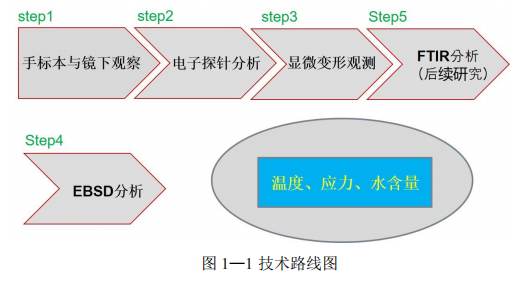
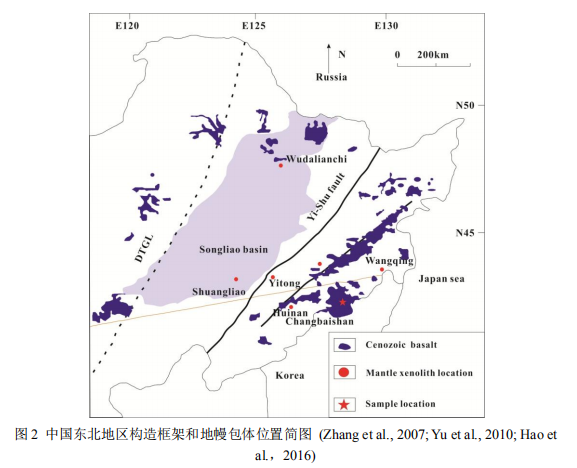
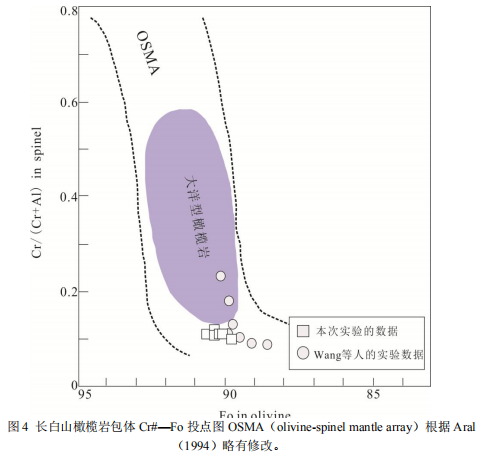
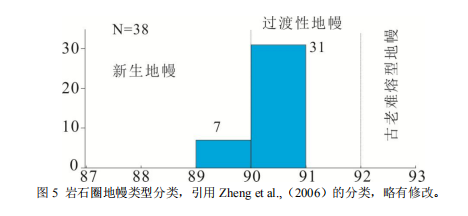
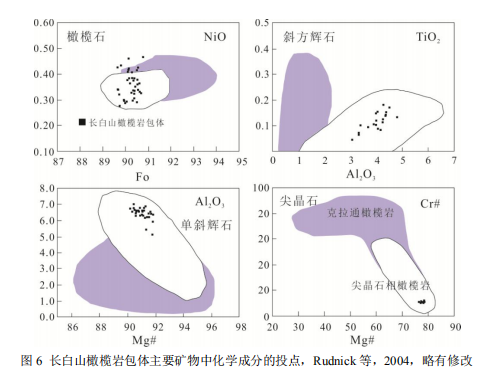
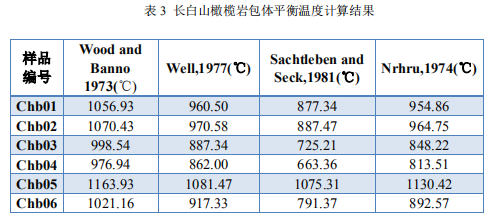
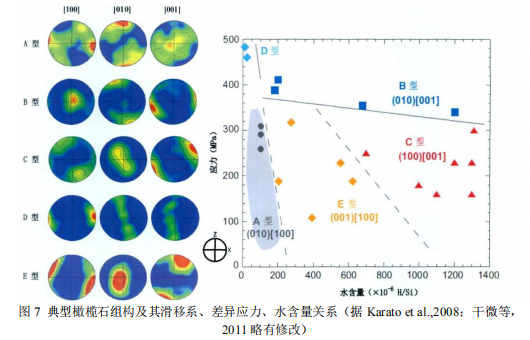
第八章 结论
本文通过对长白山橄榄岩包体进行矿物组成、温压条件、显微结构及矿物晶格优选方位(LPO)的系统研究,得出以下几点认识:
(1)长白山地区橄榄岩包体主要是尖晶石相橄榄岩包体.橄榄石 Fo 值介于89-91 之间,反映了过渡型地幔的特征.尖晶石 Cr#值介于 10-12 之间,属于低铬尖晶石,该地区地幔经历了 0.97%-10.06%程度的部分熔融.整体上看,该地区的橄榄岩包体具有非克拉通区的特征.
(2)该地区橄榄岩包体平衡温度约为 850℃-1100℃之间,岩石圈上地幔差异流动应力范围 30-38MPa 之间,应变速率约为 ,有效粘滞度约为
,有效粘滞度约为  .
.
(3)该地区橄榄石组构主要为 A 型组构,反映包体形成于贫水相对低应力的环境,与大陆岩石圈环境相符.
(4)华北克拉通东北缘上地幔在化学成分或温度上存在较大程度的不均一性,而差异应力场则较为均一.
参考文献
[1] Arai, S. (1994). "Characterization of spinel peridotites by olivine-spinel compositionalrelationships: Review and interpretation." Chemical Geology 113(3): 191-204.
[2] Arai, S., S. Ishimaru and V. M. Okrugin (2003). "Metasomatized harzburgite xenoliths fromAvacha volcano as fragments of mantle wedge of the Kamchatka arc: Implication for themetasomatic agent." Island Arc 12(2): 233-246.
[3] Ave Lallemant, H. G., J. C. C. Mercier, N. L. Carter and J. V. Ross (1980). "Rheology of theupper mantle: Inferences from peridotite xenoliths." Tectonophysics 70(1): 85-113.
[4] Becker, S. (1930). "Gefügekunde der Gesteine." Berlin: Sp ringer.
[5] Bunge, H.-J. (1982). Texture analysis in materials science : mathematical methods. London ;,Butterworths.
[6] Cao, Y., H. Jung and S. Song (2017). "Olivine fabrics and tectonic evolution of fore‐arcmantles: A natural perspective from the Songshugou dunite and harzburgite in the Qinlingorogenic belt, central China." Geochemistry, Geophysics, Geosystems 18(3): 907-934.
[7] Cao, Y., H. Jung and S. Song (2018). "Seismic anisotropies of the Songshugou peridotites(Qinling orogen, central China) and their seismic implications." Tectonophysics 722: 432-446.
[8] Cao, Y., S. Song, L. Su, H. Jung and Y. Niu (2016). "Highly refractory peridotites inSongshugou, Qinling orogen: Insights into partial melting and melt/fluid-rock reactions in forearcmantle." Lithos 252-253: 234-254.
[9] Chen, L., W. Tao, L. Zhao and T. Zheng (2008). "Distinct lateral variation of lithosphericthickness in the Northeastern North China Craton." Earth and Planetary Science Letters 267(1):56-68.
[10] Chen, L., T. Zheng and W. Xu (2006). "A thinned lithospheric image of the Tanlu Fault Zone,eastern China: Constructed from wave equation based receiver function migration." Journal ofGeophysical Research: Solid Earth 111(B9).
[11] Chopra, P. N. and M. S. Paterson (1984). "The role of water in the deformation of dunite."Journal of Geophysical Research: Solid Earth 89(B9): 7861-7876.
[12] Drury, M. R., H. G. Avé Lallemant, G. M. Pennock and L. N. Palasse (2011). "Crystal preferred orientation in peridotite ultramylonites deformed by grain size sensitive creep, ?tang deLers, Pyrenees, France." Journal of Structural Geology 33(12): 1776-1789.
[13] Falus, G., A. Tommasi, J. Ingrin and C. Szabó (2008). "Deformation and seismic anisotropyof the lithospheric mantle in the southeastern Carpathians inferred from the study of mantlexenoliths." Earth and Planetary Science Letters 272(1): 50-64.
[14] H, Jung. and Karato. S (2001). "Water-induced fabric transitions in olivine." Science (NewYork, N.Y.) 293(5534).
[15] Hansen, L. N., M. E. Zimmerman and D. L. Kohlstedt (2012). "The influence ofmicrostructure on deformation of olivine in the grain-boundary sliding regime." Journal ofGeophysical Research: Solid Earth 117(B9).
[16] Hao, Y.-T., Q.-K. Xia, Z.-B. Jia, Q.-C. Zhao, P. Li, M. Feng and S.-C. Liu (2016). "Regionalheterogeneity in the water content of the Cenozoic lithospheric mantle of Eastern China." Journalof Geophysical Research: Solid Earth 121(2): 517-537.
[17] Hellebrand, E., J. E. Snow, H. J. B. Dick and A. W. Hofmann (2001). "Coupled major andtrace elements as indicators of the extent of melting in mid-ocean-ridge peridotites." Nature 410:677.
[18] Holtzman, B. K., D. L. Kohlstedt, M. E. Zimmerman, F. Heidelbach, T. Hiraga and J. Hustoft(2003). "Melt Segregation and Strain Partitioning: Implications for Seismic Anisotropy andMantle Flow." Science 301(5637): 1227-1230.
[19] Hu, S., L. He and J. Wang (2000). "Heat flow in the continental area of China: a new dataset." Earth and Planetary Science Letters 179(2): 407-419.
[20] sma , W. B. and D. Mainprice (1998). "An olivine fabric database: an overview of uppermantle fabrics and seismic anisotropy." Tectonophysics 296(1): 145-157.
[21] Jian, W. (2012). "Behavior of Siderophile and Chalcophile Elements in the SubcontinentalLithospheric Mantle beneath the Changbaishan Volcano, NE China." 地质学报:英文版 86(2).
[22] Jian, W., L. Jinlin, H. Keiko, X. Wenliang, X. Zhipeng and S. Yue (2012). "Behavior ofSiderophile and Chalcophile Elements in the Subcontinental Lithospheric Mantle beneath theChangbaishan Volcano, NE China." Acta Geologica Sinica - English Edition 86(2): 407-422.
[23] Jung, H., I. Katayama, Z. Jiang, T. Hiraga and S. Karato (2006). "Effect of water and stresson the lattice-preferred orientation of olivine." Tectonophysics 421(1): 1-22.
[24] Jung, H., W. Mo and H. W. Green (2009). "Upper mantle seismic anisotropy resulting frompressure-induced slip transition in olivine." Nature Geoscience 2(1): 73-77.
[25] Karato, S.-i., H. Jung, I. Katayama and P. Skemer (2008). "Geodynamic Significance ofSeismic Anisotropy of the Upper Mantle: New Insights from Laboratory Studies." Annual Reviewof Earth and Planetary Sciences 36(1): 59-95.
[26] Lysak, S. V. (2009). "Thermal history, geodynamics, and current thermal activity oflithosphere in China." Russian Geology and Geophysics 50(9): 815-825.
[27] M, B. (2000). "High shear strain of olivine aggregates: rheological and seismicconsequences." Science (New York, N.Y.) 5496(290).
[28] Mainprice, D., A. Tommasi, H. Couvy, P. Cordier and D. J. Frost (2005). "Pressure sensitivityof olivine slip systems and seismic anisotropy of Earth's upper mantle." Nature 433(7027):731-733.
[29] McLaren, A. C. (1978). "Crystalline plasticity and solid state flow in metamorphic rocks."Earth-Science Reviews 14(2): 171-172.
[30] Mercier, J. C. C. and A. Nicolas (1975). "Textures and Fabrics of Upper-Mantle Peridotites asIllustrated by Xenoliths from Basalts." Journal of Petrology 16(2): 454-487.
[31] Michibayashi, K., Y. Kusafuka, T. Satsukawa and S. J. Nasir (2012). "Seismic properties ofperidotite xenoliths as a clue to imaging the lithospheric mantle beneath NE Tasmania, Australia."Tectonophysics 522-523: 218-223.
[32] Nehru, C. E. and P. J. Wyllie (1974). "Electron microprobe measurement of pyroxenescoexisting with H2O-undersaturated liquid in the join CaMgSi2O6-Mg2Si2O6-H2O at 30 kilobars,with applications to geothermometry." Contributions to Mineralogy and Petrology 48(3): 221-228.
[33] Ohuchi, T., T. Kawazoe, Y. Nishihara and T. Irifune (2012). "Change of olivine a-axisalignment induced by water: Origin of seismic anisotropy in subduction zones." Earth andPlanetary Science Letters 317-318: 111-119.
[34] Ohuchi, T., T. Kawazoe, Y. Nishihara, N. Nishiyama and T. Irifune (2011). "High pressureand temperature fabric transitions in olivine and variations in upper mantle seismic anisotropy."Earth and Planetary Science Letters 304(1): 55-63.
[35] Park, Y. and H. Jung (2015). "Deformation microstructures of olivine and pyroxene in mantlexenoliths in Shanwang, eastern China, near the convergent plate margin, and implications for seismic anisotropy." International Geology Review 57(5-8): 629-649.
[36] Raterron, P., E. Amiguet, J. Chen, L. Li and P. Cordier (2009). "Experimental deformation ofolivine single crystals at mantle pressures and temperatures." Physics of the Earth and PlanetaryInteriors 172(1): 74-83.
[37] Raterron, P., J. Chen, T. Geenen and J. Girard (2011). "Pressure effect on forsteritedislocation slip systems: Implications for upper-mantle LPO and low viscosity zone." Physics ofthe Earth and Planetary Interiors 188(1): 26-36.
[38] Raterron, P., J. Girard and J. Chen (2012). "Activities of olivine slip systems in the uppermantle." Physics of the Earth and Planetary Interiors 200-201: 105-112.
[39] Ross, C. S., A. T. Myers and M. D. Foster (1954). "Origin of dunites and of olivine-richinclusions in basaltic rocks1." American Mineralogist 39(9-10): 693-737.
[40] Rudnick, R. L., S. Gao, W.-l. Ling, Y.-s. Liu and W. F. McDonough (2004). "Petrology andgeochemistry of spinel peridotite xenoliths from Hannuoba and Qixia, North China craton." Lithos77(1): 609-637.
[41] Sachtleben, T. and H. A. Seck (1981). "Chemical control of Al-solubility in orthopyroxeneand its implications on pyroxene geothermometry." Contributions to Mineralogy and Petrology78(2): 157-165.
[42] Sodoudi, F., X. Yuan, Q. Liu, R. Kind and J. Chen (2006). "Lithospheric thickness beneaththe Dabie Shan, central eastern China from S receiver functions." Geophysical JournalInternational 166(3): 1363-1367.
[43] Tommasi, A., D. Mainprice, G. Canova and Y. Chastel (2000). "Viscoplastic self-consistentand equilibrium-based modeling of olivine lattice preferred orientations: Implications for theupper mantle seismic anisotropy." Journal of Geophysical Research: Solid Earth 105(B4):7893-7908.
[44] Tommasi, A., A. Vauchez and D. A. Ionov (2008). "Deformation, static recrystallization, andreactive melt transport in shallow subcontinental mantle xenoliths (Tok Cenozoic volcanic field,SE Siberia)." Earth and Planetary Science Letters 272(1): 65-77.
[45] Vauchez, A., F. Dineur and R. Rudnick (2005). "Microstructure, texture and seismicanisotropy of the lithospheric mantle above a mantle plume: Insights from the Labait volcanoxenoliths (Tanzania)." Earth and Planetary Science Letters 232(3): 295-314.
[46] Wang, F., X.-H. Zhou, L.-C. Zhang, J.-F. Ying, Y.-T. Zhang, F.-Y. Wu and R.-X. Zhu (2006)."Late Mesozoic volcanism in the Great Xing'an Range (NE China): Timing and implications forthe dynamic setting of NE Asia." Earth and Planetary Science Letters 251(1): 179-198.
[47] Wang Jian, L. J., Hattori Keiko,Xu Wenliang,Xie Zhipeng and Song Yue (2012). "Behavior ofSiderophile and Chalcophile Elements in the Subcontinental Lithospheric Mantle beneath theChangbaishan Volcano,NE China." Acta Geologica Sinica - English Edition 86: 16.
[48] Wanger, P. A. (1930)."The evidence of the kimberlite pipe on the constitution of outer part ofthe Earth." S.Afr.Jour.Sci. 25: 80.
[49] Wells, P. R. A. (1977). "Pyroxene thermometry in simple and complex systems."Contributions to Mineralogy and Petrology 62(2): 129-139.
[50] Wheeler, J. (2010). "Anisotropic rheology during grain boundary diffusion creep and itsrelation to grain rotation, grain boundary sliding and superplasticity." Philosophical Magazine90(21): 2841-2864.
[51] Wood, B. J. and S. Banno (1973). "Garnet-orthopyroxene and orthopyroxene-clinopyroxenerelationships in simple and complex systems." Contributions to Mineralogy and Petrology 42(2):109-124.
[52] Wu, F.-y., R. J. Walker, X.-w. Ren, D.-y. Sun and X.-h. Zhou (2003). "Osmium isotopicconstraints on the age of lithospheric mantle beneath northeastern China." Chemical Geology196(1): 107-129.
[53] Yu, S.-Y., Y.-G. Xu, J.-L. Ma, Y.-F. Zheng, Y.-S. Kuang, L.-B. Hong, W.-C. Ge and L.-X.Tong (2010). "Remnants of oceanic lower crust in the subcontinental lithospheric mantle: Traceelement and Sr-Nd-O isotope evidence from aluminous garnet pyroxenite xenoliths from Jiaohe,Northeast China." Earth and Planetary Science Letters 297(3).
[54] Zhang, M., P. Hu, Y. Niu and S. Su (2007). "Chemical and stable isotopic constraints on thenature and origin of volatiles in the sub-continental lithospheric mantle beneath eastern China."Lithos 96(1): 55-66.
[55] Zhang, S. and S.-i. Karato (1995). "Lattice preferred orientation of olivine aggregatesdeformed in simple shear." Nature 375(6534): 774-777.
[56] Zhao, L., R. M. Allen, T. Zheng and S.-H. Hung (2009). "Reactivation of an Archean craton:Constraints from P- and S-wave tomography in North China." Geophysical Research Letters 36(17).
[57] Zheng, J., W. L. Griffin, S. Y. O'Reilly, J. Yang, T. Li, M. Zhang, R. Y. Zhang and J. G. Liou(2006). "Mineral Chemistry of Peridotites from Paleozoic, Mesozoic and Cenozoic Lithosphere:Constraints on Mantle Evolution beneath Eastern China." Journal of Petrology 47(11): 2233-2256.
[58] 白志达, 徐德斌, 张秉良, 张焘,卜景 (2006). "龙岗火山群第四纪爆破式火山作用类型与期次研究." 岩石学报(06): 1473-1480.
[59] 陈孝德, 林传勇, 张小鸥, 史兰斌 (1997). "山西大同第四纪火山岩中幔源包体的变形特征及其上地幔流变学意义." 地震地质(04): 26-33.
[60] 樊祺诚, 隋建立, 王团华, 李霓, 孙谦 (2006). "长白山天池火山粗面玄武岩的喷发历史与演化." 岩石学报(06): 1449-1457.
[61] 方同辉, 马鸿文 (1999). "辽宁宽甸地区上地幔岩石圈组成及热结构--来自地幔岩包体的信息." 地质论评 45(S1): 450-457.
[62] 干微, 金振民, 王根厚, 徐海军 (2011). "吉林辉南幔源橄榄岩流变学与组构特征及其动力学启示." 地质学报(04): 491-504.
[63] 金振民, 余日东, 杨文采, 欧新功 (2003). "江苏东海县幔源橄榄岩包体及其深部构造意义." 地质学报(04): 451-462+595-596.
[64] 李曙光, 汪洋 (2018). "中国东部大地幔楔形成时代和华北克拉通岩石圈减薄新机制- -深部再循环碳的地球动力学效应." 中国科学:地球科学 48(07): 809-824.
[65] 刘从强, 解广轰 (1993). "辽宁宽甸黄椅山玄武岩中地幔岩捕虏体的 REE 及 Sr、Nd 同位素地球化学." 地质科学(03): 228-234.
[66] 刘嘉麒 (1999). "中国火山." 科学出版社.
[67] 刘俊来, 曹淑云, 邹运鑫, 宋志杰 (2008). "岩石电子背散射衍射(EBSD)组构分析及应用." 地质通报(10): 1638-1645.
[68] 刘若新, 樊祺诚, 郑祥身, 张明, 李霓 (1998). "长白山天池火山的岩浆演化." 中国科学(D 辑:地球科学)(03): 226-231.
[69] 刘祥, 张成梁 (1997). "龙岗火山群四海火山渣层-来自金龙顶子火山亚普林尼式火山爆发." 吉林地质(03): 2-9+27.
[70] 鲁江姑, 郑建平 (2011). "辉南新生代玄武岩中橄榄岩捕虏体矿物化学与华北岩石圈地幔演化." 地质学报 85(03): 330-342.
[71] 路凤香, 邓晋福, 鄂莫岚 (1981). "辽宁宽甸黄椅山碱性玄武岩岩浆起源问题的讨论."地球科学(01): 183-196+279.
[72] 罗照华 (1984). "吉林辉南大椅山玄武岩中超镁铁岩包体的研究." 地球科学(01):73-80+137.
[73] 曲元贵 (1959). "长白山区玄武岩中的球状橄榄岩." 地质月刊(06): 24-25.
[74] 宋樾, 王建, 刘金霖, 谢志鹏, K. H.HATTORI (2013). "吉林东部汪清新生代玄武岩中地幔包体的矿物化学:对该地区岩石圈地幔形成过程的启示." 地学前缘 20(05): 75-86.
[75] 隋建立, 樊祺诚, 刘嘉麒, 郭正府 (2007). "长白山火山地幔不均一性--微量元素及同位素地球化学研究." 岩石学报(06): 1512-1520.
[76] 王勤, 嵇少丞, 许志琴 (2007). "橄榄石的晶格优选定向、含水量与地震波各向异性:对大陆俯冲带变形环境的约束." 岩石学报(12): 3065-3077.
[77] 吴春明 (2009). "地幔岩矿物压力计评述." 岩石学报 25(09): 2089-2112.
[78] 吴福元, 徐义刚, 高山, 郑建平 (2008). "华北岩石圈减薄与克拉通破坏研究的主要学术争论." 岩石学报(06): 1145-1174.
[79] 徐海军, 金淑燕, 郑伯让 (2007). "岩石组构学研究的最新技术--电子背散射衍射(EBSD)." 现代地质(02): 213-225.
[80] 徐荣, 刘勇胜, 宗克清, 邹东雅, 邓黎旭, 童喜润, 胡兆初, 高山 (2013). "宽甸橄榄岩包体微区地球化学特征及其岩石圈地幔演化." 岩石矿物学杂志(05): 613-636.
[81] 徐义刚 (1993). "适用于幔源包体的地质温度计." 岩石学报(02): 167-180.
[82] 徐义刚, 黄小龙, M. F. THIRLWALL, 陈小明 (2003). "吉林辉南"反应"成因方辉橄榄岩包体及其深部动力学意义." 岩石学报(01): 19-26.
[83] 徐义刚, 林传勇, 史兰斌, J-C.C.Mercier, J.V.Ross (1995). "中国东部上地幔地温线及其地质意义." 中国科学(B 辑 化学 生命科学 地学)(08): 874-881.
[84] 徐义刚,林传勇 (1996). "吉林汪清尖晶石橄榄岩包体的矿物化学成分指示意义──上地幔温度史和交代作用." 地球化学(05): 481-493+529.
[85] 许志琴, 陈晶, 王勤, 曾令森, 杨经绥, 陈方远, 李天福, 梁凤华 (2005). "南苏鲁芝麻房石榴石橄榄岩中橄榄石的"C"类组构及其形成条件探讨." 岩石学报(02): 389-397.
[86] 杨清福, 王建, H. KH, 盘晓东, 刘金霖, 谢志鹏, 宋樾 (2011). "吉林南部辉南-靖宇地区岩石圈地幔氧化-还原状态及研究意义." 岩石学报 27(06): 1797-1809.
[87] 张志海, 郑建平, 马鸿文 (2006). "吉林汪清-辉南地幔透辉石微量元素及其记录的地幔熔融与交代作用." 地质科技情报(06): 9-16.
[88] 赵起超, 夏群科, 刘少辰, 陈欢, 冯敏 (2015). "吉林汪清和龙岗新生代岩石圈地幔的含水性和元素地球化学特征." 地学前缘 22(01): 360-373.
[89] 郑建平, 戴宏坤 (2018). "西太平洋板片俯冲与后撤引起华北东部地幔置换并导致陆内盆-山耦合." 中国科学:地球科学 48(04): 436-456.
[90] 郑建平, 路凤香, 余淳梅, O. R. S. Y (2003). "地幔置换作用:华北两类橄榄岩及其透辉石微量元素对比证据." 地球科学(03): 235-240.
[91] 郑建平, 余淳梅, 路凤香, 张志海, 汤华云 (2007). "华北东部大陆地幔橄榄岩组成、年龄与岩石圈减薄." 地学前缘(02): 87-97.
[92] 郑瑞伦, 邹天人 (2006). "宽甸火山群地质遗迹的地质特征与特殊性." 地质与资源(01):75-77.
[93] 支霞臣, 秦协 (2004). "中国东部地幔橄榄岩捕虏体的 Re-Os 同位素地球化学:岩石圈地幔的形成年龄和减薄作用的制约." 岩石学报(05): 3+1-9.
[94] 周琴, 吴福元, 储着银, 杨岳衡, 孙德有, 葛文春 (2007). "吉林蛟河地幔橄榄岩捕虏体的 Sr-Nd-Hf-Os 同位素特征与岩石圈地幔时代." 岩石学报(06): 1269-1280.
[95] 周新华 (1979). "地幔成因岩石和矿物的钕同位素与地幔的演化." 地震地质译丛(03):51-52.
[96] 朱元卓 (2014). 吉林汪清橄榄岩包体流变学、组构学及地震波各向异性研究 硕士, 中国地质大学(北京).





